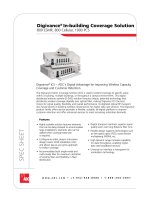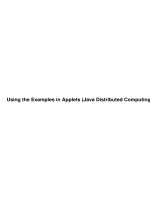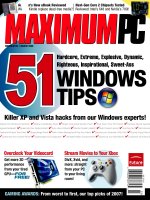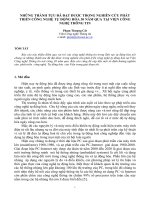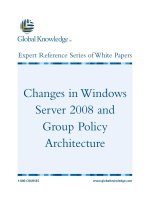Tài liệu MacRuby in Action pptx
Bạn đang xem bản rút gọn của tài liệu. Xem và tải ngay bản đầy đủ của tài liệu tại đây (16.04 MB, 270 trang )
MANNING
Brendan G. Lim
WITH Jerry Cheung
AND Jeremy McAnally
IN ACTION
www.it-ebooks.info
MacRuby in Action
www.it-ebooks.info
www.it-ebooks.info
MacRuby in Action
BRENDAN G. LIM
WITH JERRY CHEUNG
AND JEREMY MCANALLY
MANNING
SHELTER ISLAND
www.it-ebooks.info
For online information and ordering of this and other Manning books, please visit
www.manning.com. The publisher offers discounts on this book when ordered in quantity.
For more information, please contact
Special Sales Department
Manning Publications Co.
20 Baldwin Road
PO Box 261
Shelter Island, NY 11964
Email:
©2012 by Manning Publications Co. All rights reserved.
No part of this publication may be reproduced, stored in a retrieval system, or transmitted, in
any form or by means electronic, mechanical, photocopying, or otherwise, without prior written
permission of the publisher.
Many of the designations used by manufacturers and sellers to distinguish their products are
claimed as trademarks. Where those designations appear in the book, and Manning
Publications was aware of a trademark claim, the designations have been printed in initial caps
or all caps.
Recognizing the importance of preserving what has been written, it is Manning’s policy to have
the books we publish printed on acid-free paper, and we exert our best efforts to that end.
Recognizing also our responsibility to conserve the resources of our planet, Manning books are
printed on paper that is at least 15 percent recycled and processed without elemental chlorine.
Development editor: Sara Onstine
Manning Publications Co. Technical proofreader: Nick Howard
20 Baldwin Road Copyeditors: Lianna Wlasiuk, Tiffany Taylor
PO Box 261 Proofreader: Melody Dolab
Shelter Island, NY 11964 Typesetter: Marija Tudor
Cover designer: Marija Tudor
ISBN: 9781935182498
Printed in the United States of America
1 2 3 4 5 6 7 8 9 10 – MAL – 18 17 16 15 14 13 12
www.it-ebooks.info
v
brief contents
PART 1 STARTING WITH MACRUBY 1
1
■
Introducing MacRuby 3
2
■
Using Macirb and the Apple development tools 37
3
■
Going beyond the basics with Xcode Interface Builder 64
PART 2 TAKE IT FOR A SPIN 85
4
■
Using the delegate pattern 87
5
■
Notifications and implementing the observer pattern 104
6
■
Using key-value coding and key-value observing 120
7
■
Implementing persistence with Core Data 141
8
■
Core Animation basics 168
PART 3 MACRUBY EXTRAS 187
9
■
HotCocoa 189
10
■
MacRuby testing 203
11
■
MacRuby and the Mac App Store 216
www.it-ebooks.info
www.it-ebooks.info
vii
contents
preface xiii
acknowledgments xiv
about this book xvi
about the authors xix
about the cover illustration xx
PART 1 STARTING WITH MACRUBY 1
1
Introducing MacRuby 3
1.1 Introducing MacRuby 4
The MacRuby difference 4
■
Setting up your environment 5
Hello World, part 1 6
1.2 Cocoa: What you need to know 7
Important classes and concepts 8
■
How Cocoa implements
common design patterns 10
1.3 Objective-C and Ruby: what you need to know 11
A shared heritage 12
■
Objective-C 101 13
Ruby 101 17
www.it-ebooks.info
CONTENTS
viii
1.4 Diving into MacRuby 21
Class structure 21
■
Creating MacRuby classes 23
Syntax and method signatures 24
■
Using Ruby and
Objective-C methods 26
■
Creating user interfaces 27
1.5 Hello World, part 2 28
Creating an Xcode project 29
■
Creating the interface 30
Creating the controller 32
■
Connecting the interface and
controller 34
1.6 Summary 35
2
Using Macirb and the Apple development tools 37
2.1 Using external libraries with MacRuby 38
Loading frameworks 38
■
Loading Objective-C libraries as
bundles 39
■
Loading Ruby gems 41
2.2 Exploring Macirb 42
Comparing the Ruby and MacRuby consoles 42
Working in the MacRuby console 43
■
Macirb tips
and tricks 43
2.3 Building a Pomodoro application in Xcode 47
Creating a new MacRuby project 47
■
Constructing the
interface 50
■
Creating the controller 53
■
Connecting the
controller and the interface 56
■
Running the application 58
Releasing the application 58
2.4 Summary 63
3
Going beyond the basics with Xcode Interface Builder 64
3.1 About Interface Builder 65
History of Interface Builder 65
■
Getting around Interface
Builder 65
3.2 Creating connections 69
Understanding outlets 69
■
Understanding actions 71
3.3 Creating the Todo List application 73
Constructing the user interface 73
■
Creating the
model 79
■
Creating the controller 79
■
Connecting
outlets and actions 82
■
Running and packaging the
application 83
3.4 Summary 84
www.it-ebooks.info
CONTENTS
ix
PART 2 TAKE IT FOR A SPIN 85
4
Using the delegate pattern 87
4.1 What are delegates? 88
How do delegate methods work? 88
■
Implementing the delegate
pattern 89
4.2 Delegation as an extension technique 92
Delegation the Cocoa way 93
■
Delegation using
Forwardable 93
4.3 Using delegation in a custom MacRuby web browser 94
Creating the browser interface 94
■
Setting up the
controller 95
■
Implementing delegate methods in the
controller 98
■
Connecting outlets and actions 100
Taking MacRuby Browser for a spin 102
4.4 Summary 103
5
Notifications and implementing the observer pattern 104
5.1 Notifying multiple objects 105
When to use notifications 105
■
Managing notifications 106
5.2 Setting up notifications 107
Creating notifications 108
■
Posting notifications to the
notification center 108
5.3 Queuing notifications 109
Using posting styles 109
■
Coalescing notifications 110
Queuing multiple notifications 112
■
Removing
notifications 113
5.4 Responding to notifications 114
Adding notification observers 114
■
Removing notification
observers 116
5.5 Building an iTunes-notification observer 116
Creating the script 116
■
Running the script 118
5.6 Summary 118
6
Using key-value coding and key-value observing 120
6.1 Simplifying code with key-value coding 121
Accessing object properties with KVC 121
■
Handling
unknown keys 123
■
Understanding key paths and collection
operators 125
www.it-ebooks.info
CONTENTS
x
6.2 Using KVO to implement observers 128
Adding and removing observers 128
■
Manually notifying
observers of changes 129
■
Responding to observed
objects 130
6.3 Building out the Product Inventory application 131
Creating the user interface 131
■
Using KVC to retrieve product
information 132
■
Adding features with KVC and KVO 137
6.4 Summary 140
7
Implementing persistence with Core Data 141
7.1 Introducing Core Data 142
Core Data concepts 142
■
Differences between Core Data and
traditional databases 142
■
Creating a base Core Data
project 143
7.2 Understanding the persistent store and managed
objects 145
Anatomy of a persistent store 146
■
Working with the managed
object model 147
■
Working with entity properties 149
Defining a managed object class 152
7.3 Working with managed objects 154
Creating managed objects and updating properties 154
Persisting changes to managed objects 155
7.4 Retrieving objects from Core Data 157
Filtering and sorting with predicates and descriptors 157
Fetching objects from Core Data 158
7.5 Creating a Core Data version of the Todo List application 160
Building the user interface 160
■
Creating the tasks
controller 161
■
Connecting the interface to the controller 164
Running the application and inspecting the persistent store 166
7.6 Summary 167
8
Core Animation basics 168
8.1 Introduction to Core Animation 169
What is Core Animation? 169
■
Class structure 169
Core Animation’s rendering architecture 170
■
Creating a
basic animation with Cocoa Animation 171
www.it-ebooks.info
CONTENTS
xi
8.2 Core Animation layers 173
Layer coordinate systems 174
■
Layer geometry 174
Layer content 175
8.3 Animating with Core Animation 179
Basic animations 179
■
Keyframe animations 181
Grouping animations 182
8.4 Summary 185
PART 3 MACRUBY EXTRAS 187
9
HotCocoa 189
9.1 Introducing HotCocoa 189
Getting started 190
9.2 Built-in mappings 191
Applications and menus 191
■
Windows and controls 193
More advanced layouts 198
9.3 Building a speech application using HotCocoa 200
Laying out the views 200
■
Making your application
speak to you 201
9.4 Summary 202
10
MacRuby testing 203
10.1 Testing MacRuby applications with MiniTest 203
10.2 Installing and configuring MiniTest 205
10.3 Application vs. logic testing 207
10.4 Where to start testing 209
Application initialization 209
■
Core Data 210
Managing persistence store for testing 212
■
Testing
predicates 214
10.5 Summary 215
11
MacRuby and the Mac App Store 216
11.1 Introducing the Mac App Store 217
Benefits of releasing on the Mac App Store 217
■
Limitations
of the Mac App Store 218
www.it-ebooks.info
CONTENTS
xii
11.2 Knowing the App Store rules 219
Functionality 219
■
Metadata 219
■
Location 219
User interface 219
■
Privacy 220
■
Charities and
contributions 220
■
Legal requirements 220
11.3 Submitting a MacRuby application 220
Creating certificates 220
■
Registering your Mac App ID 223
Preparing icons and screenshots 224
■
Adding your
application to iTunes Connect 225
■
Packaging and
submitting your application 227
■
Dealing with application
rejection 231
■
Submitting an update 231
11.4 Summary 231
appendix A Scripting with MacRuby 232
index 241
www.it-ebooks.info
xiii
preface
When I was first learning Ruby, I immediately fell in love with the language. I knew
early on that I wanted to work with Ruby professionally, which became possible later
when I created my first startup using Ruby on Rails.
I later worked for a Ruby on Rails consulting company where I spent a few years
focusing on Ruby before I headed up the mobile development department. I’ve had
an interest in mobile development since I was young and it was a very exciting time to
work on i
OS and Android applications. With iOS development came the need to learn
Objective-C, which ultimately led me into the world of Cocoa for Mac development.
I developed a few Mac applications personally and professionally and thought how
great it would be if I could write Mac applications using Ruby. I’d heard of Ruby-
Cocoa, but I knew of its shortcomings. Then I learned about MacRuby: it was the solu-
tion I’d been waiting for.
When I was contacted by Manning to work on this book, I knew I’d be able to
reach many other individuals who were Rubyists and who wanted to create rich Mac
applications without having to use Objective-C. This book is meant for you if you love
the Ruby language and want to get into Mac development
B
RENDAN G. LIM
www.it-ebooks.info
xiv
acknowledgments
Putting together a book like this is no easy feat, and many people behind the scenes
worked countless hours to get the book into your hands. First and foremost, everyone
at Manning deserves all the thanks we can give them. Without them, we wouldn’t have
been able to create such a great book for you.
We interacted frequently with a few individuals from Manning and would like to
specifically mention them. We’d like to thank Troy Mott, our acquisitions editor, who
originally came to us to work on this book and helped us through thick and thin. Sara
Onstine, our development editor, guided us through the formalities of writing a book
like this. And Marjan Bace, our publisher, always challenged us to find ways to
improve the book’s content and organization.
We’d also like to thank our book’s production team. Lianna Wlasiuk, Tiffany Tay-
lor, and Melody Dolab, our copyeditors and proofreader, read the entire manuscript
and made sure everything was organized and presented properly. Nick Howard, our
technical proofreader, caught errors that we didn’t know were there.
Over the course of the development of the book, many people generously volun-
teered to review it to help make it as good as it could be. These reviewers deserve a tre-
mendous amount of credit for the impact they made through their feedback. Our
thanks to Pradeep Elankumaran, Brent Collier, Adam Bair, Philip Hallstrom, Mike
Stok, Alex Vollmer, Coby Randquist, Jerry Cheung, Greg Vaughn, Warner Onstine,
and Daniel Bretoi.
www.it-ebooks.info
ACKNOWLEDGMENTS
xv
BRENDAN would like to thank his father, Chhorn, his mother, Brenda, and his two
brothers, Chhorn and Chhun, for their support and encouragement. He also wants to
thank his wife, Edelweiss, for her love and support and for letting him spend night
and day working on this book. Last but not least, thanks to Pradeep Elankumaran,
who let Brendan spend so much time writing this book after they both quit their jobs
to focus on their startup, Kicksend.
J
ERRY would like to thank his parents, Margaret and Kevin, and his wise-guy brother
Randall. He’d also like to remind Wendy that he beat her to her thesis (thanks, love,
for letting me win this one). A special shout-out goes to Brendan for getting Jerry
interested in MacRuby and Mac development in the first place.
J
EREMY would like to thank his wife, friends, and dogs for sustaining him through yet
another writing project. Without their support, he would likely end up a raving maniac
under an overpass tapping out code examples while throwing cans at passing cars.
www.it-ebooks.info
xvi
about this book
MacRuby in Action was written to give Rubyists the ability to create rich Cocoa applica-
tions for the Mac OS X platform without having to learn Objective-C. Our goal is to
have you, the reader, creating amazing Cocoa applications using MacRuby by the end
of the book. Throughout the book, you’ll learn in the ins and outs of MacRuby while
exploring the Cocoa framework, design patterns, system scripting, testing, and getting
your application into the Mac App Store. We know that sometimes the best way to
learn is to get your feet wet. That’s why you’ll be creating useful Mac applications
along the way so you can apply the key topics as you learn them.
Who should read this book
This book is aimed at developers interested in writing software for the Mac platform.
It doesn’t matter if you’re new to both the Mac and the Ruby language or you’re an
experienced Ruby developer looking to learn how to write Mac apps. If you have the
desire to create beautiful Cocoa applications for the Mac platform and want to do so
using the elegant and highly productive Ruby language, then this book is for you. If
you’re new to Ruby, we give you a brief overview of the language so you’ll feel comfort-
able enough to take on the rest of the book.
MacRuby in Action is also a more approachable introduction to Cocoa development
than traditional Objective-C books. Throughout the book, we explore practical code
examples that you’ll face when creating your own applications. MacRuby in Action can
act as a guide for using MacRuby and Cocoa from the ground up, or you can use it as
a reference if you’re looking to dive deeper into MacRuby.
www.it-ebooks.info
ABOUT THIS BOOK
xvii
Roadmap
The book has 11 chapters divided into three parts as follows:
Chapter 1 explores the inner workings of MacRuby and how to set up your devel-
opment environment. There’s also an introduction to Ruby and an overview of
Objective-C syntax. We then go into the MacRuby syntax, give a few examples, and
end with two “Hello World” examples.
Chapter 2 takes a deeper dive into MacRuby with more in-depth examples. We
look into using external frameworks, Ruby gems, and the MacRuby console. At the
end of the chapter, you build a MacRuby Pomodoro application.
Chapter 3 talks about Apple’s development environment tools. You spend more
time using Xcode’s Interface Builder to create rich Cocoa user interfaces. You then
use your Interface Builder knowledge to create an application to manage to-do lists.
Chapter 4 introduces and explains a code design technique known as delegation.
This design pattern is used often in the Cocoa framework and is important to know
because it’s a core concept. You explore delegation by creating a web browser with
MacRuby.
Chapter 5 covers Cocoa’s notification system, which lets you set observers through-
out an application to listen for and react to changes. This is another pattern that is
used frequently in Cocoa. At the end of the chapter, you build an iTunes notification
observer.
Chapter 6 explores key value coding
(KVC) and observing. KVC is a mechanism in
Objective-C that’s used throughout Cocoa. You learn about KVC, bindings, and key-
value observing.
Chapter 7 introduces the Core Data framework. Core Data is Apple’s answer to
object-relational mapping. We compare Core Data with other persistence solutions
that you may be familiar with. At the end of the chapter, you use Core Data to add per-
sistence to the Todo List application you built in chapter 3.
Chapter 8 discusses image manipulation, animation, and much more with Core
Animation. Throughout the chapter, we go through examples to showcase what you
can do with Core Animation once you scratch the surface.
Chapter 9 dives into the MacRuby-oriented mapping library HotCocoa. HotCocoa
gives developers an alternative to Interface Builder by making it easy to create inter-
faces in code. You end up building a small application of your own.
Chapter 10 discusses testing with MacRuby. Testing is an essential part of software
development, and it has gained a strong focus within the Ruby community. We look at
different ways to test with MacRuby.
Chapter 11 explains how to release a MacRuby application to the world with the
Mac App Store. We go into detail about the different review guidelines, how to provi-
sion your application for submission, and finally how to submit it for review.
Appendix A talks about scripting with MacRuby. We first provide a little history and
an introduction to AppleScript. We then look at how you can use MacRuby to create
scripts to automate functionality.
www.it-ebooks.info
ABOUT THIS BOOK
xviii
Code conventions
There are many code examples throughout this book. These examples always appear
in a
fixed-width code font
. If we want you to pay special attention to a part of an
example, it appears in a
bolded code font
. Any class name or method within the
normal text of the book appears in code font as well.
Many of Cocoa’s methods have exceptionally long and verbose names. Because of
this, line-continuation markers (
➥
) may be included in code listings when necessary.
Not all code examples in this book are complete. Often we show only a method or
two from a class to focus on a particular topic. Complete source code for the applica-
tions found throughout the book can be downloaded from the publisher's website at
www.manning.com/MacRubyinAction.
Software requirements
An Intel-based Macintosh running OS X 10.6 or higher is required to develop Mac-
Ruby applications. You also need to download MacRuby, but it’s freely available at
.
The book offers full coverage of MacRuby and Xcode 4.
Author Online
Purchase of MacRuby in Action includes free access to a private web forum run by Man-
ning Publications where you can make comments about the book, ask technical ques-
tions, and receive help from the authors and from other users. To access the forum
and subscribe to it, point your web browser to www.manning.com/MacRubyinAction.
This page provides information on how to get on the forum once you’re registered,
what kind of help is available, and the rules of conduct on the forum.
Manning’s commitment to our readers is to provide a venue where a meaningful
dialog between individual readers and between readers and the authors can take
place. It’s not a commitment to any specific amount of participation on the part of the
authors, whose contribution to the
AO remains voluntary (and unpaid). We suggest
you try asking the authors some challenging questions lest their interest stray!
The Author Online forum and the archives of previous discussions will be accessi-
ble from the publisher’s website as long as the book is in print.
www.it-ebooks.info
xix
about the authors
BRENDAN G. LIM is a professional Ruby and Objective-C developer. He is also a noted
conference speaker who specializes in developing Ruby on Rails, Android, iOS, and
Mac applications. Brendan graduated from Auburn University where he studied Wire-
less Software Engineering. He is also a Y Combinator alum and cofounded the file-
sharing startup Kicksend. During his free time, Brendan enjoys rock climbing and tak-
ing photos and videos.
J
ERRY CHEUNG loves creating software. He started experimenting with Ruby on Rails in
2007 and has been hooked on Ruby ever since. Upon graduating from Berkeley, he
joined Coupa, and later he went on to start his own company, Outspokes, with several
friends from Berkeley. He currently works as a Rails engineer at Intridea and experi-
ments with emerging technologies like MacRuby and Node.js. When he’s not furiously
typing, Jerry might be out running, brewing beer, or enjoying a
BBQ and getting a seri-
ous sunburn.
J
EREMY MCANALLY is founder and principal at Arcturo, a web and mobile development
firm. He spends his days hacking Ruby and Objective-C.
www.it-ebooks.info
xx
about the cover illustration
The figure on the cover of MacRuby in Action is captioned “A man from Ubli, Dalma-
tia.” The illustration is taken from a reproduction of an album of Croatian traditional
costumes from the mid-nineteenth century by Nikola Arsenovic, published by the Eth-
nographic Museum in Split, Croatia, in 2003. The illustrations were obtained from a
helpful librarian at the Ethnographic Museum in Split, itself situated in the Roman
core of the medieval center of the town: the ruins of Emperor Diocletian’s retirement
palace from around AD 304. The book includes finely colored illustrations of figures
from different regions of Croatia, accompanied by descriptions of the costumes and
of everyday life.
Ubli is a town on the island of Lastovo, one of a number of small islands in the
Adriatic off the western coast of Croatia. The figure on the cover wears blue woolen
trousers and a white linen shirt, over which he dons a blue vest and black jacket, richly
trimmed with the colorful embroidery typical for this region. A red turban and color-
ful socks complete the costume. The man is also holding a pistol and has a short
sword tucked under his belt.
Dress codes and lifestyles have changed over the last 200 years, and the diversity by
region, so rich at the time, has faded away. It’s now hard to tell apart the inhabitants of
different continents, let alone of different hamlets or towns separated by only a few
miles. Perhaps we have traded cultural diversity for a more varied personal life—
certainly for a more varied and fast-paced technological life.
Manning celebrates the inventiveness and initiative of the computer business with
book covers based on the rich diversity of regional life of two centuries ago, brought
back to life by illustrations from old books and collections like this one.
www.it-ebooks.info
Part 1
Starting with MacRuby
MacRuby is a combination of technologies that together create a power-
ful and very usable new technology. Part 1 of this book provides the basics
needed for new MacRuby users to understand the background and underlying
details of how MacRuby works so the development environment, language, and
platform make sense. With this grounding, you’ll be able to pick any sections in
the rest of the book and learn about the areas that are most interesting or rele-
vant to you.
www.it-ebooks.info
www.it-ebooks.info
3
Introducing MacRuby
MacRuby gives you the ability to write full-fledged Mac applications while enjoying
the benefits of the Ruby language. You won’t take a deep dive into writing your first
releasable application worthy of the Mac App Store just yet—you’ll do that in chap-
ter 2. To write great MacRuby applications, you first need to become familiar with
its foundation. The MacRuby language is deeply rooted in the Ruby and Objective-
C languages so it’s important to have a good understanding of both of these to fully
leverage all that MacRuby offers.
In this chapter, we’ll briefly cover the Cocoa framework, Ruby, and Objective-C.
After you have an understanding of these topics, we’ll dive into some real MacRuby
code. You’ll even get a chance to write a Hello World application; we’ll show you
two approaches to user interface development.
To get started, let’s learn what MacRuby is all about and get it installed on your
system.
This chapter covers
■
Exploring and installing MacRuby
■
Important Cocoa concepts
■
Objective-C and Ruby fundamentals
■
MacRuby syntax and methods
■
Developing with the Xcode IDE
www.it-ebooks.info
4 CHAPTER 1 Introducing MacRuby
1.1 Introducing MacRuby
MacRuby is an Apple-sponsored development project. Over the years, Apple has
shown support for Ruby as a language, and, since 2002, Apple has included Ruby as
part of the
Mac OS X operating system. Apple bundled a Ruby Scripting Bridge imple-
mentation called RubyCocoa with Mac OS X Leopard. Prior to MacRuby, RubyCocoa
was the only way to work with Ruby and the Cocoa framework together.
In this section, you’ll learn how MacRuby is different from past attempts at com-
bining Ruby and Objective-C and what makes it such a great language. We’ll also jump
right into getting MacRuby installed onto your system and introduce you to Mac-
Ruby’s class structure.
Let’s set the stage for MacRuby.
1.1.1 The MacRuby difference
The goal of MacRuby is to provide an implementation of the Ruby language on top of
core Mac OS X technologies, such as the Objective-C runtime, garbage collection, and
Core Foundation. In MacRuby, all classes are Objective-C classes, all methods are
Objective-C methods, and all objects are Objective-C objects. Unlike RubyCocoa, you
don’t need a bridge between Ruby, Objective-C, and the Cocoa framework. MacRuby
is implemented on top of the Objective-C runtime as shown in figure 1.1.
MacRuby gives you the ability to do almost any-
thing you want with the Mac platform—all while giv-
ing you the clean, concise syntax of the Ruby
language. Another thing that sets it apart from
RubyCocoa is that you get this functionality without
making performance sacrifices because MacRuby
doesn’t rely on a bridge implementation.
MacRuby is similar in concept to the IronRuby
and
JRuby projects in that it’s an implementation of
Ruby on top of another runtime. IronRuby runs on the .NET runtime for Windows,
and JRuby runs on the Java Virtual Machine (JVM) runtime. MacRuby is currently
under active development by Apple, which gives the language a great deal of support
and momentum.
Think of MacRuby as the child of two languages: Objective-C and Ruby. MacRuby is
rooted in the Objective-C object hierarchy, but it also has the Ruby 1.9 core function-
ality layered on top. Syntax-wise, MacRuby resembles Ruby more than Objective-C.
Theoretically, you could write a Ruby 1.9 script and run it under MacRuby. The key dif-
ference in MacRuby is that you can directly access Objective-C frameworks, classes,
objects, and methods.
Before you write any code, you’ll want to install MacRuby and Xcode on your sys-
tem. Xcode is Apple’s suite of developer tools needed to create
Mac OS X applications.
After all, what good are code examples if you can’t follow along?
Objective-C
Objective-C runtime
MacRuby
Cocoa libraries
Ruby libraries
Figure 1.1 MacRuby is built on top
of the Objective-C runtime.
www.it-ebooks.info
